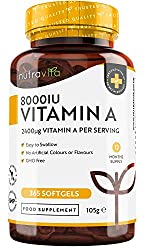Vitamin A
Vitamin A is a fat-soluble vitamin, which means they are soluble in organic solvents and absorb and move in the same way that fats do.. Its many forms are referred to as “retinoids.” Retinol, retinal, retinoic acid, and retinyl ester are some of them.

Vitamin A
Vitamin A is a fat-soluble vitamin, which means they are soluble in organic solvents and absorb and move in the same way that fats do.. Its many forms are referred to as “retinoids.” Retinol, retinal, retinoic acid, and retinyl ester are some of them.
Overview
Vitamin A (retinol, retinoic acid) is a nutrient that is necessary for eyesight, cell division, reproduction, and immunity. Antioxidant properties are also present in vitamin A. Antioxidants are chemicals created when your body breaks down food or is exposed to tobacco smoke or radiation, and they may protect your cells from the impacts of free radicals. Heart disease, cancer, and other disorders may all be linked to free radicals.
Many foods, such as spinach, dairy products, and liver, contain vitamin A. Foods high in beta-carotene, such as green leafy vegetables, carrots, and melons, are also good sources. Beta-carotene is converted to vitamin A in your body.
Vitamin A is mostly used as an oral supplement to help those who have a poor or limited diet or who have a condition that raises their vitamin A requirement, such as pancreatic illness, eye disease, or measles. Keep in mind that if you take vitamin A for its antioxidant characteristics, the supplement may not provide the same advantages as naturally occurring antioxidants in food.
Source
Sources of Vitamin A
- Cheese
- Eggs
- Fatty fish
- Low-fat spreads with added vitamins
- Yoghurt and milk
- Liver and liver products, such as liver pâté – this is a particularly rich source of vitamin A, so eating it more than once a week may put you at risk of having too much vitamin A (if you’re pregnant, avoid eating liver or liver products).
- Spinach, carrots, sweet potatoes, and red peppers are examples of yellow, red, and green (leafy) vegetables.
- Mango, papaya, and apricots are examples of yellow fruits.
Uses & effectiveness
Vitamin A, also known as retinol, serves a variety of purposes.
These are some of them:
- Skin that is ageing. In adults with aged skin, applying vitamin A (retinol) to the skin improves skin colour, flexibility, and wrinkles. It’s unclear whether non-prescription retinol is as effective as prescription retinoids like tretinoin (Renova).
- Measles. In children with measles and vitamin A insufficiency, taking vitamin A by mouth appears to minimise the risk of measles complications or death.
- Capacity to see in low-light environments. In malnourished adults, taking vitamin A by mouth during pregnancy appears to reduce night blindness by 37%. When vitamin A is combined with zinc, it may be more effective in treating this illness.
- The most common cause of white patches inside the mouth is smoking (oral leukoplakia). These lesions can be treated by taking high-dose vitamin A orally.
- Death from any cause. In children under the age of five who are in danger of vitamin A deficiency, taking high-dose vitamin A by mouth reduces the chance of death. In healthy people, taking vitamin A does not appear to lessen the chance of death.
- Complications that occur after a child is born. In malnourished people, taking vitamin A by mouth before, during, and after pregnancy lowers diarrhoea and the risk of death after delivery.
- Symptoms of poor night vision and loss of side vision are eye disorders (retinitis pigmentosa) that have been inherited. Vitamin A taken orally can help to reduce the progression of a retina-damaging eye condition.
- Inflammatory bowel disease (ulcerative colitis). Adults with ulcerative colitis can benefit from taking vitamin A orally every day for two months to alleviate symptoms.
- Sun damage causes wrinkles in the skin. In females with sun-damaged skin, applying non-prescription vitamin A (retinol) serum to the skin improves skin smoothness and wrinkles. It may be as effective as prescription products for treating skin wrinkles, such as tretinoin (Renova).
Although there is little scientific evidence to substantiate these treatments, Vitamin A has also been used for:
- Allergies and allergic reactions. A risk (atopic disease). Giving infants a single dose of vitamin A by mouth does not appear to prevent atopy.
- Lung disease. Primarily affecting newborns (bronchopulmonary dysplasia). In most low birth weight infants, injecting vitamin A as a shot does not reduce the risk of breathing problems. Only a healthcare provider can administer vitamin A shots.
- Unborn or premature baby deaths. Taking vitamin A orally before, during, or after pregnancy appears to have no effect on infant mortality during the first year of life. Also, giving vitamin A to infants by mouth does not appear to prevent infant death.
- Parasite infection of the intestines. A single oral dose of vitamin A does not appear to prevent reinfection in children taking medicine to treat intestinal parasites.
- The most severe form of skin cancer (melanoma). Taking a high dose of vitamin A orally does not appear to improve survival in melanoma patients.
- Miscarriage. Taking vitamin A orally, either alone or in combination with other vitamins, before or during early pregnancy has no effect on the risk of miscarriage or stillbirth.
- Tuberculosis. Oral vitamin A supplementation does not appear to improve symptoms or reduce the risk of death in people with this condition.
There is no scientific proof that Vitamin A treats:
- Cancer of the head and neck. In people with head and neck cancer, taking vitamin A by mouth does not reduce the risk of developing new tumours or improve survival.
- Transmission of HIV. Taking vitamin A orally has no effect on the risk of HIV transmission to the foetus during pregnancy, newborns during delivery, or infants during breastfeeding. Taking vitamin A supplements during pregnancy may increase the risk of HIV transmission to babies through breast milk.
- Infection of the lower respiratory tract. Oral vitamin A does not prevent or alleviate symptoms of lower airway infections in children.
- Pneumonia. Taking vitamin A orally has no effect on the treatment or prevention of pneumonia in children living in developing countries.
There is some interest in using vitamin A for a variety of other purposes, but there isn’t enough reliable scientific evidence to substantiate whether it’s beneficial.
Side Effects
When taken orally, vitamin A is probably safe in doses less than 10,000 units (3,000 mcg) per day. There are two types of vitamin A: preformed vitamin A (retinol or retinyl ester) and provitamin A. (carotenoids). The maximum daily dose only applies to pre-formed vitamin A.
When taken in doses greater than 10,000 units (3,000 mcg) per day, preformed vitamin A may be dangerous. Higher doses may increase the likelihood of side effects. Long-term use of large amounts may result in serious side effects such as mental changes.
When applied to the skin, vitamin A may be safe when used in moderation. Retinol 0.5 percent serum has been used daily for up to 12 weeks with no adverse effects.
Some research suggests that consuming more than an average of 1.5 mg (1,500 g) of vitamin A per day for many years may affect your bones, making them more prone to fracture as you age.
This is especially important for older people, particularly women, who are already at a higher risk of osteoporosis, a bone-weakening condition.
You may be getting too much vitamin A if you eat liver or liver pâté more than once a week.
Vitamin A is found in many multivitamins. Other vitamin A-rich supplements, such as fish liver oil, are also available.
If you take vitamin A supplements, make sure your daily intake from food and supplements does not exceed 1.5 mg (1,500 g).
If you eat liver once a week, avoid taking vitamin A supplements.
If you get any side effects, talk to your doctor, pharmacist or nurse. This includes any possible side effects not listed on this page. In the UK you can also report side effects directly to the Yellow Card Scheme By reporting side effects you can help provide vital information on the safety of this medical supplement.
Is this medicine suitable for you?
Take precautions:
- Pregnant and breastfeeding. If you’re pregnant or planning to have a baby, avoid taking vitamin A supplements, including fish liver oil, unless your doctor tells you to. Also, avoid eating liver or liver products, such as pâté, which are high in vitamin A. It is probably safe in recommended amounts of less than 10,000 units (3,000 mcg) of preformed vitamin A daily. Larger amounts are potentially hazardous and can result in birth defects. During the first three months of pregnancy, keep track of your vitamin A intake from all sources. Vitamin A can be found in a variety of foods, including animal liver, fortified breakfast cereals, and dietary supplements.
- Children. When taken in the recommended amounts, vitamin A is most likely safe. The maximum amount of vitamin A that is safe for children is determined by their age. When taken in large doses, vitamin A may be harmful to children. Side effects of high doses include irritability, sleepiness, diarrhoea, and other issues.
- Menopause. Women who have gone through menopause should limit their intake of vitamin A to no more than 1.5mg per day from food and supplements.
- Osteoporosis. Women and older men who are at a higher risk of osteoporosis should limit their vitamin A intake to no more than 1.5mg per day from food and supplements.
- Excessive alcohol consumption. Drinking alcohol may increase the potentially harmful effects of vitamin A on the liver.
- Disorders in which the body does not absorb fat properly. People with fat absorption disorders do not absorb vitamin A properly. Celiac disease, short gut syndrome, jaundice, cystic fibrosis, pancreatic disease, and cirrhosis of the liver are examples of these conditions. If you have one of these conditions, take carotenoids, which are water-soluble forms of vitamin A.
- Iron deficiency. A lack of iron may impair the body’s ability to use vitamin A.
- Liver disease. Too much vitamin A may aggravate the liver disease. If you have liver disease, avoid taking vitamin A supplements.
- Malnutrition. Taking vitamin A supplements may result in an excess of vitamin A in the body in people who are severely protein malnourished.
- Zinc deficiency. Zinc deficiency may cause vitamin A deficiency symptoms. To improve this condition, a combination of vitamin A and zinc supplements may be required.
Consult your doctor
If you are taking any of the following medicines please consult your doctor:
- Retinoids, which are used to treat skin conditions, interact with Vitamin A. Vitamin A is used in the manufacture of some medications for skin conditions. Taking vitamin A and these medications at the same time may result in toxic effects.
- Antibiotics (particularly tetracycline antibiotics) interact with Vitamin A. Taking high doses of vitamin A in conjunction with tetracyclines can increase the risk of a serious side effect known as intracranial hypertension. Normal doses of vitamin A, however, do not appear to cause this problem when combined with tetracyclines. If you are taking antibiotics, avoid taking large amounts of vitamin A.
- Hepatotoxic drugs (medications that harm the liver) interact with Vitamin A. Large doses of vitamin A may be harmful to the liver. Some medications can also be toxic to the liver. Taking high doses of vitamin A in conjunction with a liver-harming medication may increase the risk of liver damage.
- Warfarin (Coumadin) and Vitamin A interact. Warfarin is a medication that is used to prevent blood clots. A high intake of vitamin A can also slow blood clotting. Taking vitamin A with warfarin may increase the likelihood of bruising and bleeding. Make it a habit to have your blood tested on a regular basis. Your warfarin dose may need to be adjusted.
Dosage




